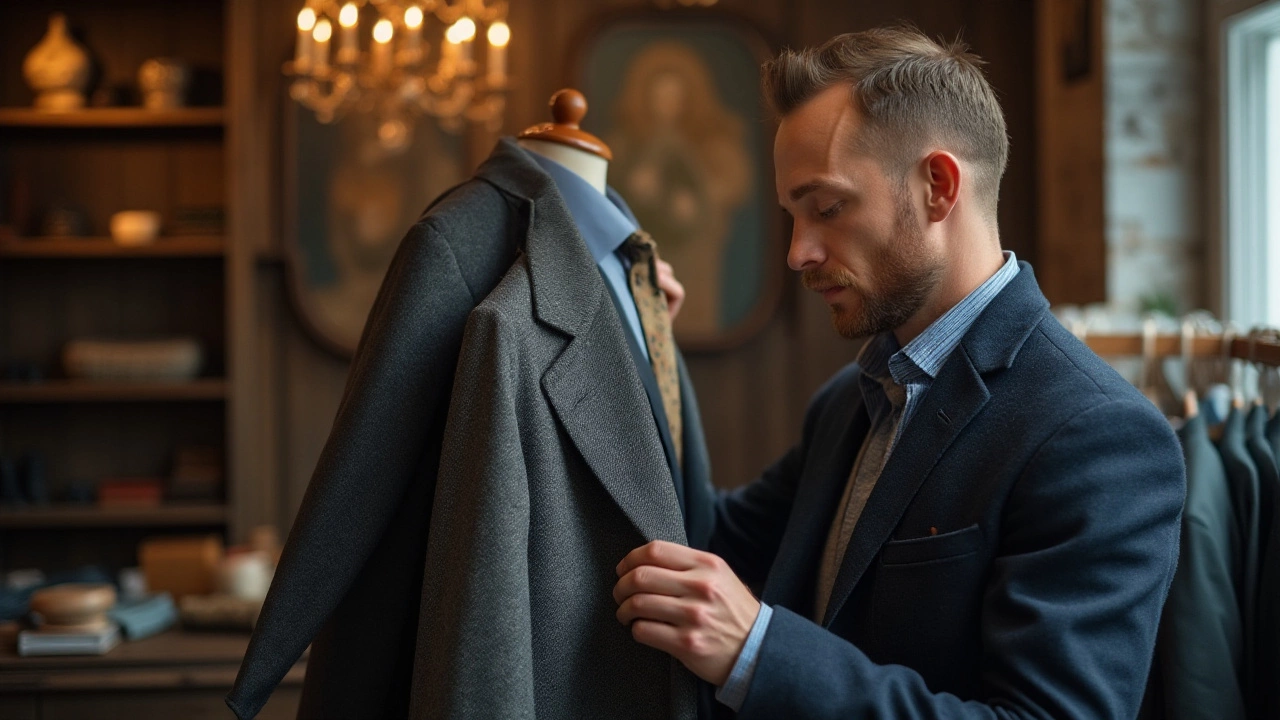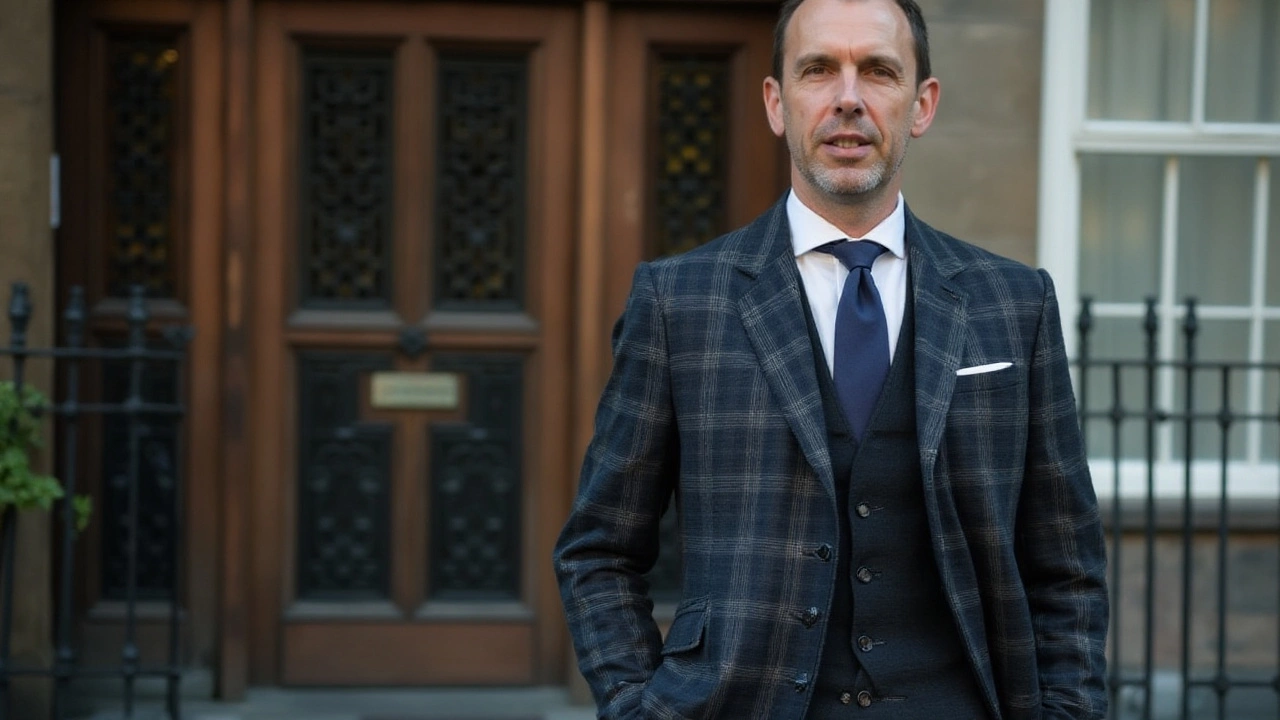In the land of lush landscapes and vibrant cities, Irish men value style that speaks of both tradition and modernity. A suit isn't merely an outfit but a statement, whether you're about town in Cork or attending a special event in Dublin. Yet, discerning a cheap suit from a high-quality one can be challenging without the right knowledge at your fingertips.
For many in Ireland, where the weather demands practical yet polished attire, understanding the nuances of suit quality becomes crucial. From the weave of the fabric to the cut's precision, each detail plays a part in determining a suit's worth. So, how can one ensure they aren't caught in a sartorial slump? Let’s delve into the world of suits and ensure your garb is as dignified as the rolling Emerald Isle itself.
- The Importance of Fabric Quality
- Understanding Suit Construction
- The Art of the Perfect Fit
- Recognizing Brand and Price Indicators
- Local Insights: Irish Tailoring and Shopping Tips
The Importance of Fabric Quality
When it comes to differentiating between a cheap suit and a masterpiece of sartorial elegance, fabric quality serves as the linchpin. In Ireland, where weather intricacies demand durable yet stylish garb, the choice of fabric becomes even more crucial. While a synthetic blend might catch less than discerning eyes, it often results in increased discomfort and decreased longevity. Wool, in contrast, remains a top choice for suits, renowned for its breathability and ability to adapt to chilly Belfast breezes and the occasional balmy day in Galway. But wool itself comes in many forms — be it Merino, Cashmere, or the sturdier Tweed, each offering its unique qualities to the discerning dresser.
Tweed, an Irish favorite, lends itself beautifully to the climate and cultural ethos here. Its durability is complemented by a rich texture that tells tales of centuries-old tradition. Merino, although less rugged, offers a lightweight option ideal for those summer soirées in Cork. Meanwhile, Cashmere, known for its luxurious softness, occasionally graces suits destined for formal events or winter gatherings. Experts often advise running one’s fingers over fabric; a smooth and reassuring feel often signals higher quality. Those in the know suggest employing a simple test: grab a fistful of fabric and release. Quality fabrics return to their original state promptly, showing few signs of crumpling. The same cannot always be said for cheaper alternatives.
“Always buy a good pair of shoes and a good suit,” advises style icon David Gandy. “A cheap suit is a false economy since it leaves a lingering impression of mediocrity.”
The visual appeal of a suit can vastly differ when viewed up-close. Patterns or textures, such as herringbone or pinstripe, establish a visual narrative that plain suits can seldom emulate. However, only a well-chosen fabric can carry off these styles with grace, enhancing the wearer’s confidence. Notably, Irish designers often strategically deploy locally sourced fabrics to preserve cultural authenticity while embracing innovative designs. Yet, with so many choices, how does one ensure the authenticity of fabric labels? Checking labels meticulously and trusting endorsements or certifications, like those from the Irish Woollen Mills, adds a layer of consumer assurance.
| Fabric Type | Properties | Recommended Usage |
|---|---|---|
| Wool | Breathable, insulates well, versatile | Business suits, evening wear |
| Tweed | Durable, traditional texture | Casual or smart-casual winter suits |
| Cashmere | Soft, provides warmth | Luxury suits, special occasions |
While the temptation to choose a suit based on immediate visual appeal or price is significant, understanding the fabric's role in the suit's lifecycle ensures better value in the long run. Whether walking into an event in the heart of Dublin or dressing for a meeting in Limerick, your choice in fabric speaks volumes about attention to detail and respect for tradition. Prepared with this knowledge, one's wardrobe selections will not only exude class and taste but also confidence in facing any occasion.
Understanding Suit Construction
When you're eyeing that sleek suit on the rack, it's easy to be drawn in by its initial appeal. Yet, the secret to a truly remarkable suit lies in its construction. This isn't merely about how it appears, but rather, how it's built—an essential marker between what's merely passable and what's impressively bespoke. A well-constructed suit in men's suits is an investment in quality and longevity, making it worth every penny for Ireland fashion enthusiasts. It’s in the meticulous sewing, the hidden interlinings, and the craftsmanship of details that separate the sheep from the goats.
The construction of a suit generally falls into three categories: fused, half-canvas, and full-canvas. These not only affect the price but also how a suit feels and fits on one's body. Fused suits, often found in cheap suit options, are made by gluing the interlining to the fabric, which while cost-effective, does not breathe as well and may lose shape over time. Conversely, a half-canvas construction involves a piece of horsehair lining sewn into the chest area, offering better drape and structure without the hefty tag. The pinnacle is the full-canvas suit, where this interlining runs the entire length of the jacket, ensuring a tailored fit that molds more beautifully to the wearer's body with each wear.
When considering a suit’s quality, it's vital to look for little tells or markers of craftsmanship, such as pick-stitching along the seams, which signals attention to detail. The lapels should roll gently, indicative of a hand-stitched lining rather than a flat, machine-made piece. It’s this handwork that sets prestigious brands apart, such as those you might find parading during Ireland's fashion showcases or traditional tailoring houses. “A well-made suit is a piece of architecture, it's engineered clothing.” Ireland-based tailor Conor Johnston once said, as noted in the Dublin Designers Journal. His words resonate with the city’s bustling scenes of both innovative and classical creations.
For those exploring higher-end options, understanding the precise stitching is essential. The finest stitches are practically invisible from the outside, holding the suit's fabric together uncompromisingly while leaving room for comfortable movement. Inside the jacket, inspect the lining; quality linings will be soft, often made of materials like cupro or Bemberg for breathability and sheen. Ensure there are sleeves head in the jackets that align correctly with your shoulder’s line, providing that seamless contour.
Lastly, keep an eye out for features not often considered but crucial to the suit's usability and style, like functional buttons on the sleeves, often termed surgeon's cuffs—an element that adds both practicality and elegance. These construction cues not only elevate the ensemble but also speak volumes about the diligent craftsmanship behind every notch and seam. Such refined details remind us that in the bustling streets of Dublin or the windswept lanes of Galway, how one's suit is constructed is just as telling as how it's worn, a true symbol of refined detected quality.

The Art of the Perfect Fit
Achieving the perfect fit is fundamental when it comes to a suit, and understanding this concept is crucial for anyone navigating the labyrinthine world of men's fashion in Ireland. A men's suit must feel like a second skin, not a stiff envelope constricting movement or, conversely, sagging like an oversized coat on a child. Irish gentlemen have long understood the importance of fit due to the diverse range of climates and occasions requiring a flexible wardrobe. From the bustling streets of Dublin to the quaint taverns of Sligo, each suit fit must marry form and function with finesse.
To master the art of the perfect fit, keep an eye on some key elements. The shoulder fit is non-negotiable as it sets the tone for the rest of the suit. When you wear a jacket, ensure that the shoulder seams end where your own shoulders do. Avoid any pulling or drooping; balance is the name of the game. Equally important is the chest fit, which should allow your suit to button comfortably without pulling. Imagine walking through Temple Bar; you want your garment to keep pace with you, not restrict or overshadow your natural movement.
Next, let's give a nod to the suit's waist. Often overlooked, the waist is a defining part of any cheap suit versus a tailored gem. A well-tailored waist shouldn’t pinch, nor should it resemble a sack. The jacket should rest lightly on your frame, a subtle dance of fabric that neither overstates nor understates. Now, combine this with the right trouser length, and you've got yourself a suit that flatters your stature. The hemline of your trousers should lightly kiss the top of your shoes—just like a whisper of warm Connemara air on a brisk autumn's day.
For those in Ireland who are serious about the sartorial arts, visiting a professional tailor might be the perfect final touch to ensure precision. A seasoned tailor, familiar with the nuances of Irish styles and builds, can transform a decent fit into something extraordinary. As the saying goes, "A tailor is not a man, but nature’s second staff upon which a well-dressed man may confidently lean." Indeed, going bespoke might be the secret weapon in acing that crucial first impression.
Statistics have shown that personalized suits command respect in both casual and formal settings. A recent survey of Irish professionals found that 72% believed well-tailored clothing positively affected their careers. Consider this when navigating suit purchases, especially when buying off-the-rack pieces. Retailers across Ireland, from House of Fraser to local bespoke shops in Cork, offer options that allow for alterations. Make use of these services to tweak and refine the suit to your liking.
Recognizing Brand and Price Indicators
Understanding the relationship between brand and price is essential in discerning the value of a suit, especially in the heart of Ireland, where discerning buyers appreciate craftsmanship and tradition. Brands often speak volumes about the quality and heritage behind a garment. In places like Dublin and Cork, you'll find high street staples like Marks & Spencer or Next offering dependable suits at accessible prices, ideal for those dabbling in their first formal wardrobe. But when prestige and refinement are non-negotiable, Irish gentlemen might turn to brands such as Magee 1866. This Donegal-based company is renowned for its luxurious tweeds, marrying local flair with timeless sophistication.
When considering price as an indicator, context is crucial. A higher price point often suggests attention to handcrafting, durable fabrics, and a superior fit, but doesn't automatically guarantee quality. It’s wise to educate oneself about a brand's history and its reputation in the menswear domain. Some well-established names, familiar to the sartorial savvy, include Louis Copeland & Sons, which has been suiting Ireland's elite for over a century. Their expert tailoring and personal consultation service offer value beyond mere fabric and stitch, crafting an experience as much as an outfit.
Nevertheless, discerning a quality suit isn't limited to recognizable labels. In fact, the Irish market also supports excellent independent designers and tailors who bring bespoke attention without the burden of brand markup. If you stumble upon tailors like Peter O'Brien or designers fresh from the studios of Grafton Street, the price may indicate a custom piece, reflecting unique personal touches and often a better economic choice for lifelong wearability. Consider the staggering difference of €300 might draw between a standard off-the-rack suit and a semi-bespoke gem, crafted with a focus on longevity and adaptability.
“An enduring suit is like a classic Irish tale—tailored with care, embellished with stories of its making, and fitting just right in every retelling,” reflects fashion expert Conor McGregor, not in the octagon, but a man known for his penchant for finesse beyond fighting.
Don't be swayed by price alone. Recognize that many department stores often implement seasonal sales, offering high-quality suits at marked-down prices. Savvy shoppers might score legendary Irish discounts at a renowned shopping fest like the Kildare Village outlet, where international brands meet local sensibilities, introducing elegance without exorbitant costs.
Moreover, price indicators can be highly subjective, fluctuating with trends and market demands. Thus, equipping oneself with knowledge about fabric, craftsmanship, and brand history remains invaluable. Whether you're swayed by the allure of an established name or intrigued by a fresh Irish talent's artistry, allow your understanding of brand and price indicators to guide your path to sartorial splendor, one well-considered decision at a time.

Local Insights: Irish Tailoring and Shopping Tips
When it comes to suiting up in Ireland, the sartorial journey often begins with choosing the right tailor. The fine art of tailoring in Ireland is grounded in a rich history, with established names like Louis Copeland & Sons and Tom Murphy continuing to forge paths in contemporary fashion with an eye on tradition. Finding a trusted tailor means more than just nabbing a quick fix—it's about ensuring longevity and finesse in every stitch of your suit. Choosing a tailor who understands the nuance of Irish weather, which can veer from drizzly morning to sunny afternoon, is essential. They’ll guide you towards appropriate fabric choices, like woolen blends that breathe well and fend off moisture. This insight into fabric durability is essential when ensuring your suit doesn’t just look good, but performs in Ireland’s unique climate.
For those stepping into the world of suits for the first time, the marketplace offers a treasure trove of options which can be both delightful and daunting. To navigate, it's crucial to understand what distinguishes the truly timeless from the fleetingly trendy. Men's suits in Ireland vary widely, with quality often being subtly hidden in the stitching or lining details that the untrained eye might miss. As Daithi O’Connor, a seasoned tailor from Dublin, once mentioned, “A well-made suit is like a good friend; it supports you when needed and never lets you down.” These distinguishing features come to light especially when one visits local boutiques known for their personalized service, where staff often recall your preferences and offer bespoke suggestions that echo the cultural ties of the region.
When comparing the broader marketplace, brands like Magee have carved out a niche with their distinct Donegal tweed, cherished not just locally but internationally. This tweed stands as a marker of quality, embodying the very emblem of matching tradition with modernity. Investing in local brands supports sustainable production and gives one a suit woven with genuine Irish heritage. An important shopping tip is to visit seasonal sales in stores around Liffey Valley or the bustling streets of Grafton Street, where top-tier quality can sometimes be picked up at a fraction of the original price.
Even as fashion leans towards globalization, Irish suits benefit from distinct geographical influences. Beyond the capital, cities like Galway offer a unique flair, bringing in artisans who balance contemporary trends with rich textures influenced by the landscape. Considering these geographical nuances, a tailored recommendation is often to have a standalone waterproof element, perhaps a tailored coat to accompany your suit, thus ensuring that you're ready for any sudden downpours typical of an Irish day.
For those visiting the island, embracing the cultural significance of the suit can be part of making a wardrobe truly personal. It’s a journey of not just dressing for a place but dressing with the place in mind. Embrace the opportunity to learn from every encounter, and your suit will tell its own story, much like the landscapes of this storied land. Keep in mind these local shopping tips and insights, and you’ll create a wardrobe that’s not only befitting for any Irish occasion but one that stands resilient and stylish wherever in the world you might find yourself.
